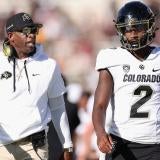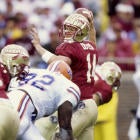Overtime in football is a popular topic these days. With both of the NFL's conference championship games going to overtime a couple of weeks ago, some have been wondering whether it's time for the NFL to change its overtime format. The fact the Chiefs never got the ball in an overtime loss to the Patriots in the AFC Championship Game made fans question whether it was sensible for the NFL to have an overtime format that makes it possible a team never gets the ball.
Many have suggested the NFL adopt an overtime format similar to that used in college football. In the college game, each team gets a possession starting at the opponent's 25-yard line in each overtime period. They then either score (whether a touchdown or field goal) or do not, and if both teams are still tied after the period, they go to another overtime. If the game remains tied after two overtime periods, teams must go for a two-point conversion following touchdowns. More often than not, this leads to games ending quicker in overtime, though last year we saw LSU and Texas A&M go seven overtimes before settling things, and even though that's a rare occurrence, it has the NCAA wondering whether or not it should reconsider its overtime format.
And the NCAA should debate that concept, but not because of the Texas A&M-LSU affair. College should change its overtime format because, even if it's better than then the one used in the NFL, it's far from perfect.
I've always felt that the smartest thing the college game could do would be to have the offense's starting field position move back with each overtime period. So if the teams start at the 25 in the first overtime, the second overtime would begin at the 35, the third at the 40, then the 45, and should it extend that long, as far back as the 50. I doubt many games would get that far.
While I liked that idea, last week, by sheer chance, I came across an overtime concept I'd never heard before. It was an idea that struck me as brilliant and the absolute best way to settle things in overtime at both the college and professional levels. I came across the idea via a tweet from Matt Hinton, but as Hinton informed me, the idea first surfaced way back in 2002 from an electrical engineer and Green Bay Packers fan named Chris Quanbeck. The idea was simple.
Overtime should begin with an auction of the football.
Hard to believe we're still arguing about how to fix OT when the answer's just been sitting here. pic.twitter.com/CV0WiuoC3Y
— Matt Hinton (@MattRHinton) January 24, 2019
Of the options available in the proposal, the silent auction makes the most sense. The coach of each team would inform the officials of where they'd be willing to begin overtime with possession of the ball without the other team knowing. Then, whichever team is willing to start furthest from the opponent's goal line would get the ball. So, if Nick Saban said he'd start at the Alabama 30 but Dabo Swinney said he'd start at the Clemson 25, Clemson would get the ball, and the first team to score would win. Both teams would have had a chance to possess the ball that wasn't dependent on the flip of a coin but their own choice.
It would bring a whole new level of strategy to the game as well. If you have a fantastic defense, you could tank the auction process. You could tell the refs you were willing to start at your opponent's 10-yard line and hope your opponent says it will begin at its own 25. Then, you'd hope for a quick three-and-out and much better field position following a punt than you would have had if you had bid with your own 20-yard line. Of course, you'd also run the risk of your opponent saying they're only willing to start at your 15, so now you've given them the ball at the 15, and they're a 32-yard field goal away from ending the game.
I mean, it's easy to envision coaches losing their jobs over this. That's horrible for coaches -- who already get fired for a billion different reasons as is -- but it would be fun as hell as a fan.
This is the overtime format football needs to adopt.
Submit your questions to be answered in this space on Twitter (@TomFornelli) or via email (tom.fornelli@cbsinteractive.com)
What is the realistic ceiling for Jeff Brohm and Purdue football? As an alumni, I think the program could top out on the same level as Michigan State, Wisconsin or Iowa type level. -- Boiler Ginger
You're not far off. It's somewhat strange, though. Brohm has been at Purdue for two seasons, and in those two seasons, the Boilermakers are 13-13. That doesn't seem like much for most programs, but considering Purdue had gone 9-39 in the four seasons before Brohm's arrival, it's a drastic improvement.
The fact Brohm has already turned down his alma mater to remain at Purdue is huge for the program as well, and he's recruiting very well. His 2018 recruiting class ranked 51st nationally and 11th in the Big Ten. As of right now, his 2019 class is 24th nationally and fifth in the Big Ten, ahead of Wisconsin, Michigan State and Iowa. And that's the most important thing.
I believe Brohm is a magnificent coach, and I was a fan of him before he got to Purdue, but there are a lot of great coaches out there. What separates a great coach from a successful coach, however, is usually talent. And Brohm is increasing the talent level at Purdue drastically. This will set Purdue up to be a force in the Big Ten West provided the talent keeps coming ... and Brohm stays. Of course, just because the Big Ten West isn't as top-heavy as the Big Ten East doesn't mean it'll be easy to do it. It's likely that 2018 was an outlier for Wisconsin; the Badgers will be back. Nebraska is on the upswing. Iowa will always be competitive. As long as Pat Fitzgerald's at Northwestern, it will be a factor. Minnesota and Illinois have a ways to go, but there's signs of improvement with both of those programs as well.
There's a chance the Big Ten's "easier" division could prove to be its strongest from top to bottom soon.
Think having to get a transfer [quarterback] is a product of poor recruiting or poor in-house development? -- @BeetchB
It does not necessarily have to be either. No program should make a habit of relying on transfer quarterbacks, as recruiting and developing your in-house is still the best path to being successful at the position, but the college football landscape has changed in recent years. Every season top quarterbacks become available on the transfer market because player movement is easier than ever before and there's no longer a stigma attached to it. It used to be that if you transferred it meant you couldn't cut it at your old school. That's still occasionally the case, but a lot of times it's just a guy looking for an opportunity to play that isn't available to him.
Jalen Hurts isn't leaving Alabama because he can't play. Justin Fields didn't leave Georgia because he can't play. Kyler Murray didn't leave Texas A&M because he couldn't play. Sometimes you take a transfer QB simply because he's a better option than what you currently have, and it doesn't mean there's anything inherently wrong with how you're recruiting or developing in your program.
How come no one talks about Alabama's schedule? Since 2011 they haven't played a nonconference road game and only played a few bowl games outside of the southeast. Next year they play 4 road games and 3 home cupcakes. I understand the SEC is toughest conference but come on. -- @DanPWalker
Actually, Dan, I wrote about this very thing last August. So my question for you is, how come every time somebody asks a question that begins with "how come no one talks about" something that thing has almost always been talked about before? Seriously, though, the reason Alabama doesn't play nonconference road games is that it doesn't have to. There's nothing more to it than that. As for all of its bowl games being played in the southeast, well, that's where the SEC has the majority of its bowl contracts. Why make your fans travel to California when they can just go to Orlando? Also, for what it's worth, Alabama is currently scheduled to play at Texas in 2022 and at Notre Dame in 2028.
The better question is why college football teams need to schedule games a decade in advance while their basketball programs can do it a season or two before, all while scheduling far more games. My guess is boredom and the need for something to do.
Is Texas back? -- Bethany Nihlean
No, but it's moving in the right direction at least.
Ultimately how successful will the Kliemate Change (FCS-P5) experiment in Manhattan, KS be? -- @__TopCat
It will all depend on how well he recruits. Bill Snyder had success recruiting junior college players during his incredible tenure at Kansas State, but it's hard to rely on the JUCO route to win successfully. Between 1995 and 2003, the Wildcats won at least 10 games in a season seven times. They managed to do so again in both 2011 and 2012, in Snyder's third and fourth season during his second stint.
That second stint is the most likely ceiling for Kansas State under Chris Klieman. Odds are he'll follow the same philosophy of developing players at Kansas State that he had at North Dakota State, and once in a while that's going to lead to a special season for the Wildcats. It's just, given the talent level of other schools in the conference like Oklahoma and Texas, it's hard to imagine Kansas State ever having another run like the one it had between 1995 and 2003.
Did an Over hurt you as a child? -- @ButtersBC
No, I just like to increase my odds of making money and being successful. Think of it this way: When you're choosing between an over and an under, in a vacuum, you have a 50 percent chance of being right and a 50 percent chance of being wrong (not accounting pushes). Well, what if I told you that, during the College Football Playoff era (since 2014), the under won 51.5 percent of the time. Now, if you'd blindly bet every under you'd have lost money because of the juice, but that's not the point. The point is if you're betting on a coin flip and you learn that tails is the winner 51.5 percent of the time, why would you bet on heads if the payout is the same?
Now, again, it's not as simple as betting unders. I look for unders before overs because history shows that the under is more likely to win. Also, you should know that in that same timeframe, underdogs have covered 50.9 percent of the time, and road underdogs have covered 52.5 percent of the time. That means that if you'd have blindly bet every road underdog against the spread since the start of the 2014, you'd have made money.
Again, I'm not saying you should do that, but if you consider gambling to be an investment, unders and underdogs have shown to be safer investments over the years, while favorites and overs are more volatile.





















